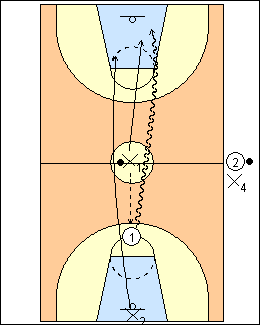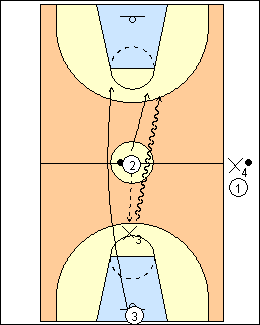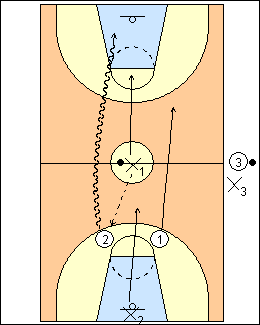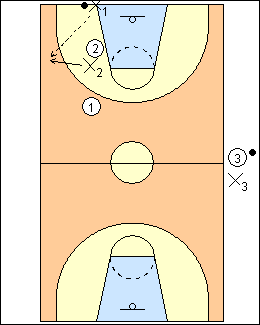Vance Walberg Texas
 | 1 Vance Walberg Two teams alternate attacks, play to 8 points with regular scoring, the losers run up and back in 10 seconds, the winners must validate their win - the player who scored the winning basket must make a foul shot, or his team doesn't get the win, and they do five push-ups. Texas 11 X1 at halfcourt passes to O1 and stays in the centre circle to try to stop him, defender X2 comes from behind starting on the baseline. O1 gets one shot, then defends a two-on-one coming back (he does not retreat right away, and can steal the ball to score again). O2 and X4 are on the sideline, remaining players are behind the baseline. When play is over, O1 goes to the sideline, get the ball to X4. Variations - defender X1 cannot move until attacker 1 hits the edge of the centre circle - the attacker comes on from a line of players on the sideline, foul-line extended, and gets a pass from that line, not from the defender at halfcourt. Rotate from halfcourt to foul line to baseline when coming off - limit of one frontcourt pass and one shot on the 2-on-1. |
 | 2 O2 comes on from the sideline as the next passer, X3 and O3 come on from behind the baseline. When play is over X3 will go to the sideline with the ball. |
 | 3 John Calipari Two teams, with players on the sidelines and baseline. O1 starts on the foul line, gets a pass from coach on a dead sprint, has to beat X1 through the circle, keeps the ball between the elbows, and tries to shoot a layup. X1 can't retreat until the ball hits the circle. X2 trails from the baseline, can't go until O1 goes, his job is to block a shot. It's 2-on-1 coming back, X5 inbounds to X1 after a make, O1 denies on the side then retreats (he can steal and attack). If the ball gets ahead, don't wait for your partner, shoot a layup, count on him to rebound a miss (don't throw a back pass in the lane, that's going to be a charge, you can throw a wrap-around pass or pass off the backboard). If the ball doesn't get ahead the two attackers get on the elbows 12 feet apart and pass back and forth. They can't rebound a miss and bring the ball down, but can tip it in. Team X goes next, with no set player rotation. Play to 6 baskets (or 3), the winners must verify their win (while the losers run) or they incur a penalty, but it's not running. See Transition - Calipari 11, which builds into Texas 11. |
 | 4 Texas 22 X1 passes to O1 or O2 then it's two-on-one with chaser X2, play to a stop or score. X1 can retreat (more game-like). John Calipari - coach passes to O1 or O2 from the sideline, if he passes to a big, the big should pass to his partner, then at halfcourt they pass back and forth. X1 can retreat or do whatever he wants. Mads Olesen - X1 passes to O1 or O2, who dribble to halfcourt then touch pass the rest of the way. |
 | 5 After a score, scorer O2 full fronts attacker X2 on the inbounds pass, while O2 plays 5-6 feet behind X2. O2 and O1 try to get a 5-second count or can keep going to score with a steal in their frontcourt. Play 2 on 2 to a stop or score coming back, new players come on, O3 will pass to team X to start play. John Calipari - it's 2-on-2 coming back, a big inbounds after a make, his defender face guards the receiver then recovers (the defenders can steal). Whoever has the ball, try to shoot a layup. Catch and pass with both hands, they don't throw bounce passes. See Transition - Calipari 22, which builds into Texas 22. |
This page was made with Basketball playbook from Jes-Soft